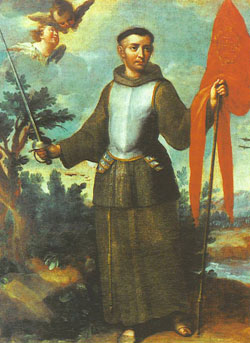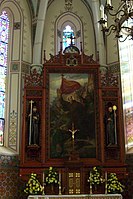
Feastday: October 23
Patron: of Jurists
Birth: 1386
Death: 1456
St. John was born at Capistrano, Italy in 1385, the son of a former German knight in that city. He studied law at the University of Perugia and practiced as a lawyer in the courts of Naples. King Ladislas of Naples appointed him governor of Perugia. During a war with a neighboring town he was betrayed and imprisoned. Upon his release he entered the Franciscan community at Perugia in 1416. He and St. James of the March were fellow students under St. Bernardine of Siena, who inspired him to institute the devotion to the holy Name of Jesus and His Mother. John began his brilliant preaching apostolate with a deacon in 1420. After his ordination he traveled throughout Italy, Germany, Bohemia, Austria, Hungary, Poland, and Russia preaching penance and establishing numerous communities of Franciscan renewal. When Mohammed II was threatening Vienna and Rome, St. John, at the age of seventy, was commissioned by Pope Callistus III to preach and lead a crusade against the invading Turks. Marching at the head of seventy thousand Christians, he gained victory in the great battle of Belgrade against the Turks in 1456. Three months later he died at Illok, Hungary. His feast day is October 23. He is the patron of jurists.
To all our readers, Please don't scroll past this.
Today, we humbly ask you to defend Catholic Online's independence. 98% of our readers don't give; they simply look the other way. If you donate just $5.00, or whatever you can, Catholic Online could keep thriving for years. Most people donate because Catholic Online is useful. If Catholic Online has given you $5.00 worth of knowledge this year, take a minute to donate. Show the volunteers who bring you reliable, Catholic information that their work matters. If you are one of our rare donors, you have our gratitude and we warmly thank you. Help Now > patron saint of military chaplains "Capistrano" redirects here. For other uses, see Capistrano (disambiguation).John of Capistrano (Italian: San Giovanni da Capestrano, Hungarian: Kapisztrán János, Polish: Jan Kapistran, Croatian: Ivan Kapistran, Serbian: Јован Капистран, Jovan Kapistran) (24 June 1386 – 23 October 1456) was a Franciscan friar and Catholic priest from the Italian town of Capestrano, Abruzzo. Famous as a preacher, theologian, and inquisitor, he earned himself the nickname 'the Soldier Saint' when in 1456 at age 70 he led a crusade against the invading Ottoman Empire at the siege of Belgrade with the Hungarian military commander John Hunyadi.
Elevated to sainthood, he is the patron saint of jurists and military chaplains, as well as the namesake of the Franciscan missions San Juan Capistrano in Southern California and San Juan Capistrano in San Antonio, Texas.
Early life
As was the custom of this time, John is denoted by the village of Capestrano, in the Diocese of Sulmona, in the Abruzzi region, Kingdom of Naples. His father had come to Italy with the Angevin court of Louis I of Anjou, titular King of Naples. He studied law at the University of Perugia.
In 1412, King Ladislaus of Naples appointed him Governor of Perugia, a tumultuous and resentful papal fief held by Ladislas as the pope's champion, in order to effectively establish public order. When war broke out between Perugia and the Malatestas in 1416, John was sent as ambassador to broker a peace, but Malatesta threw him in prison. It was during this imprisonment that he began to think more seriously about his soul. He decided eventually to give up the world and become a Franciscan friar, owing to a dream he had in which he saw Francis of Assisi and was warned by him to enter the Franciscan Order. He had married before the war, but asserted the marriage was never consummated and received permission to take holy orders.
Friar and preacher
Together with James of the Marches, John entered the Order of Friars Minor at Perugia on 4 October 1416. Along with James, he studied theology at Fiesole, near Florence, under Bernardine of Siena. He soon gave himself up to the most rigorous asceticism, violently defending the ideal of strict observance and orthodoxy, following the example set by Bernardine. From 1420 onwards, he preached with great effect in numerous cities and eventually became well known. He was ordained in 1425.
Unlike most Italian preachers of repentance in the 15th century, John was effective in northern and central Europe—in German states of Holy Roman Empire, Bohemia, Moravia, Austria, Hungary, Croatia and the Kingdom of Poland. The largest churches could not hold the crowds, so he preached in the public squares—at Brescia in Italy, he preached to a crowd of 126,000.
Reformer
 Saint John of Capistrano
Saint John of Capistrano
When he was not preaching, John was writing tracts against heresy of every kind. This facet of his life is covered in great detail by his early biographers, Nicholas of Fara, Christopher of Varese and Girlamo of Udine. While he was thus evangelizing, he was actively engaged in assisting Bernardine of Siena in the reform of the Franciscan Order, largely in the interests of a more rigorous discipline in the Franciscan communities. Like Bernardine, he strongly emphasized devotion to the Holy Name of Jesus, and, together with Bernardine, was accused of heresy on this account. In 1429, these Observant friars were called to Rome to answer charges of heresy, and John was chosen by his companions to speak for them. They were both acquitted by the Commission of Cardinals appointed to judge the accusations.
He was frequently deployed to embassies by Popes Eugene IV and Nicholas V: in 1439, he was sent as legate to Milan and Burgundy, to oppose the claims of the Antipope Felix V; in 1446, he was on a mission to the King of France; in 1451 he went at the request of the emperor as Apostolic Nuncio to Austria. During the period of his nunciature, John visited all parts of the Empire, preaching and combating the heresy of the Hussites; he also visited Poland at the request of Casimir IV Jagiellon. As legate, or inquisitor, he prosecuted the last Fraticelli of Ferrara, the Jesuati of Venice, the Crypto-Jews of Sicily, Moldavia and Poland, and, above all, the Hussites of Germany, Hungary and Bohemia; his aim in the last case was to make talks impossible between the representatives of Rome and the Bohemians, for every attempt at conciliation seemed to him to be conniving at heresy.
John, in spite of this tireless life, found time to work—both during the lifetime of his mentor, Bernardine, and afterwards—on the reform of the Order of Friars Minor. He also upheld, in his writings, speeches and sermons, theories of papal supremacy rather than the theological wranglings of councils (see Conciliar Movement). John, together with his teacher, Bernardine, his colleague, James of the Marche, and Albert Berdini of Sarteano, are considered the four great pillars of the Observant reform among the Friars Minor.
 The saint's coat of arms, with a sword piercing a crescent moon, on the Papal Ombrellino at Mission Basilica San Juan Capistrano
The saint's coat of arms, with a sword piercing a crescent moon, on the Papal Ombrellino at Mission Basilica San Juan Capistrano
Anti-Jewish incitement
John was known as the "Scourge of the Jews" for his inciting of antisemitic violence. Like some other Franciscans, he ranged over a broad area on both sides of the Alps, and his preaching to mass open-air congregations often led to pogroms. In 1450 the Franciscan "Jew-baiter" arranged a forced disputation at Rome with a certain Gamaliel called "Synagogæ Romanæ magister". Between 1451 and 1453, his fiery sermons against Jews persuaded many southern German regions to expel their entire Jewish population, and in Silesia, then Kingdom of Bohemia, at Wroclaw many were burned at the stake.
The soldier saint
After the Fall of Constantinople in 1453, the Ottoman Empire, under Sultan Mehmed II, threatened Christian Europe. That following year Pope Callixtus III sent John, who was already aged seventy, to preach a Crusade against the invading Turks at the Imperial Diet of Frankfurt. Gaining little response in Bavaria and Austria, he decided to concentrate his efforts in Hungary. John succeeded in gathering together enough troops to march onto Belgrade, which at that time was under siege by Turkish forces. In the summer of 1456, these troops, together with John Hunyadi, managed to raise the siege of Belgrade; the old and frail friar actually led his own contingent into battle. This feat earned him the moniker of 'the Soldier Priest'.
Although he survived the battle, John fell victim to the bubonic plague, which flourished in the unsanitary conditions prevailing among armies of the day. He died on 23 October 1456 at the nearby town of Ilok (now a Croatian border town on the Danube).
Sainthood and feast day
The year of John of Capistrano's canonization is variously given as 1690, by Pope Alexander VIII or as 1724 by Pope Benedict XIII. In 1890, his feast day was included for the first time in the General Roman Calendar and assigned to 28 March. In 1969, Pope Paul VI moved his feast day to 23 October, the day of his death. Where Mass and the Office are said according to the 1962 Roman Missal and its concomitant calendar, his feast day remains on March 28.
-

Statue of John of Capistrano in Budapest, Hungary
-

Painting in St. John of Capistrano Church in Ilok, Croatia, where he was buried
-

Monument in Vienna, near St. Stephen's Cathedral
-

In the Nuremberg Chronicle
Eponym
As a Franciscan reformer preaching simplicity, John became the eponym of two Spanish missions founded by the Franciscan friars in the north of the then-Spanish Americas: Mission San Juan Capistrano in present-day Southern California and Mission San Juan Capistrano just outside the city center of present-day San Antonio in Texas.
Patron saint
He is the patron saint of military chaplains and jurists.









